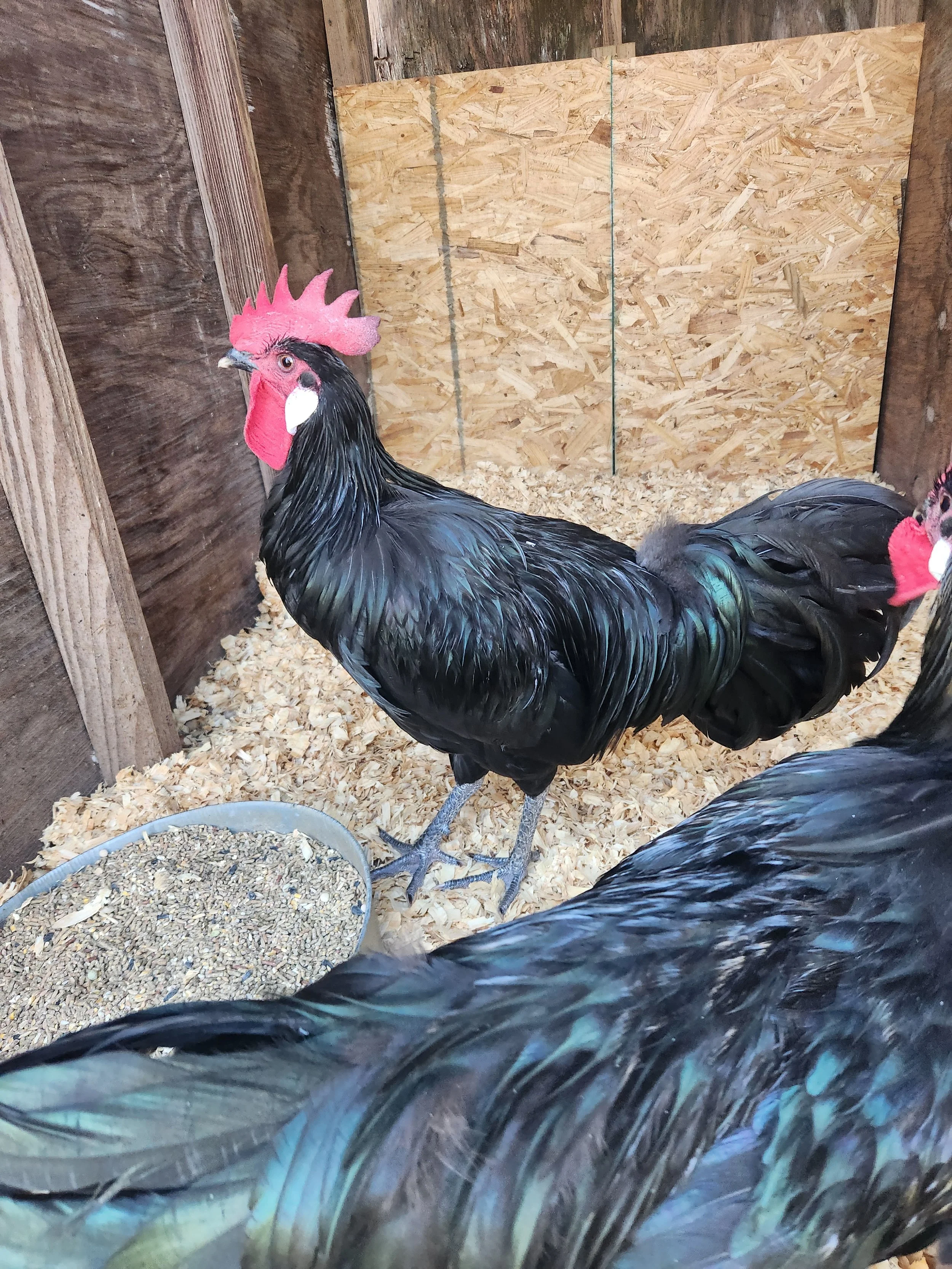 Image 1 of 2
Image 1 of 2

 Image 2 of 2
Image 2 of 2



Large Fowl Single-Comb Black Minorca Chicks
Large Fowl Single-Comb Black Minorcas
Acquired in October 2025 from Zack Duncan (Louisiana)—2 cockerels and 3 pullets—our LF Black Minorcas fill a specific niche here: a fast-developing, large-fowl utility line we can use to recreate/reinforce other breeds when needed. They’re big, productive, and thrifty birds that love room to roam; give them space and they’re easy keepers.
Quick facts (standard & variety)
Class: Mediterranean (Large Fowl); Variety: Single-Comb Black Minorca — APA-recognized.
Standard weights (APA): Cock 9 lb, Hen 7.5 lb, Cockerel 7.5 lb, Pullet 6.5 lb.
Line size note (from Zack Duncan): This line has produced roosters (cocks) up to ~15 lb and hens up to ~13 lb on occasion. Those are exceptional birds and not the norm, but it speaks to the size potential in this family.
Type details: Large single comb (erect on males; often lops on females), white earlobes, dark/slate legs, long body, tight feathering, lustrous green-black plumage.
Production & personality
Eggs: Prolific layers of large white eggs—noted for strong, steady production.
Temperament: Active, alert, and excellent foragers—still straightforward to manage if you give them room.
Why we keep them
Faster development than Cochins and strong production make Minorcas ideal when we need to rebuild numbers or outcross for vigor in select projects—without sacrificing size.
Care notes for new keepers
Space matters: They prefer plenty of range; plan larger pens or supervised free-range.
Heat vs. cold: They handle heat well; in cold, protect that large comb from frostbite (draft-free, dry housing).
Feed & condition: Quality ration + roaming keeps condition and output high.
General management: Hardy and low-fuss when kept dry, clean, and uncrowded.
What you’ll see in our pen
Tall, rangy frames with a bold single comb, white lobes, slate legs, and a deep green-sheened black surface. These Minorcas are here to work—fast-growing, productive, and useful as a foundation utility line alongside our exhibition programs.
Large Fowl Single-Comb Black Minorcas
Acquired in October 2025 from Zack Duncan (Louisiana)—2 cockerels and 3 pullets—our LF Black Minorcas fill a specific niche here: a fast-developing, large-fowl utility line we can use to recreate/reinforce other breeds when needed. They’re big, productive, and thrifty birds that love room to roam; give them space and they’re easy keepers.
Quick facts (standard & variety)
Class: Mediterranean (Large Fowl); Variety: Single-Comb Black Minorca — APA-recognized.
Standard weights (APA): Cock 9 lb, Hen 7.5 lb, Cockerel 7.5 lb, Pullet 6.5 lb.
Line size note (from Zack Duncan): This line has produced roosters (cocks) up to ~15 lb and hens up to ~13 lb on occasion. Those are exceptional birds and not the norm, but it speaks to the size potential in this family.
Type details: Large single comb (erect on males; often lops on females), white earlobes, dark/slate legs, long body, tight feathering, lustrous green-black plumage.
Production & personality
Eggs: Prolific layers of large white eggs—noted for strong, steady production.
Temperament: Active, alert, and excellent foragers—still straightforward to manage if you give them room.
Why we keep them
Faster development than Cochins and strong production make Minorcas ideal when we need to rebuild numbers or outcross for vigor in select projects—without sacrificing size.
Care notes for new keepers
Space matters: They prefer plenty of range; plan larger pens or supervised free-range.
Heat vs. cold: They handle heat well; in cold, protect that large comb from frostbite (draft-free, dry housing).
Feed & condition: Quality ration + roaming keeps condition and output high.
General management: Hardy and low-fuss when kept dry, clean, and uncrowded.
What you’ll see in our pen
Tall, rangy frames with a bold single comb, white lobes, slate legs, and a deep green-sheened black surface. These Minorcas are here to work—fast-growing, productive, and useful as a foundation utility line alongside our exhibition programs.